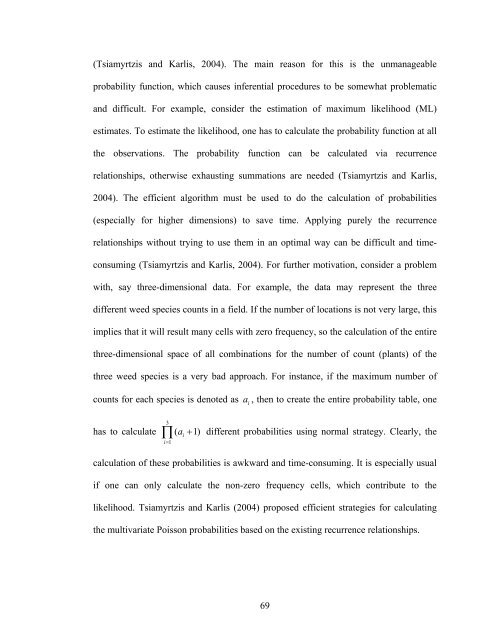multivariate poisson hidden markov models for analysis of spatial ...
multivariate poisson hidden markov models for analysis of spatial ...
multivariate poisson hidden markov models for analysis of spatial ...
You also want an ePaper? Increase the reach of your titles
YUMPU automatically turns print PDFs into web optimized ePapers that Google loves.
(Tsiamyrtzis and Karlis, 2004). The main reason <strong>for</strong> this is the unmanageable<br />
probability function, which causes inferential procedures to be somewhat problematic<br />
and difficult. For example, consider the estimation <strong>of</strong> maximum likelihood (ML)<br />
estimates. To estimate the likelihood, one has to calculate the probability function at all<br />
the observations. The probability function can be calculated via recurrence<br />
relationships, otherwise exhausting summations are needed (Tsiamyrtzis and Karlis,<br />
2004). The efficient algorithm must be used to do the calculation <strong>of</strong> probabilities<br />
(especially <strong>for</strong> higher dimensions) to save time. Applying purely the recurrence<br />
relationships without trying to use them in an optimal way can be difficult and timeconsuming<br />
(Tsiamyrtzis and Karlis, 2004). For further motivation, consider a problem<br />
with, say three-dimensional data. For example, the data may represent the three<br />
different weed species counts in a field. If the number <strong>of</strong> locations is not very large, this<br />
implies that it will result many cells with zero frequency, so the calculation <strong>of</strong> the entire<br />
three-dimensional space <strong>of</strong> all combinations <strong>for</strong> the number <strong>of</strong> count (plants) <strong>of</strong> the<br />
three weed species is a very bad approach. For instance, if the maximum number <strong>of</strong><br />
counts <strong>for</strong> each species is denoted as a<br />
i<br />
, then to create the entire probability table, one<br />
has to calculate<br />
3<br />
∏ ( ai<br />
+ 1) different probabilities using normal strategy. Clearly, the<br />
i=<br />
1<br />
calculation <strong>of</strong> these probabilities is awkward and time-consuming. It is especially usual<br />
if one can only calculate the non-zero frequency cells, which contribute to the<br />
likelihood. Tsiamyrtzis and Karlis (2004) proposed efficient strategies <strong>for</strong> calculating<br />
the <strong>multivariate</strong> Poisson probabilities based on the existing recurrence relationships.<br />
69















